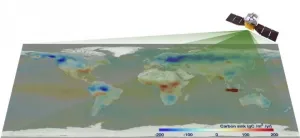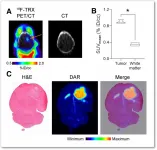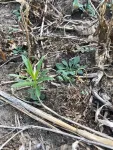China's carbon-monitoring satellite reports global carbon net of six gigatons
2021-07-23
(Press-News.org) About six gigatons -- roughly 12 times the mass of all living humans -- of carbon appears to be emitted over land every year, according to data from the Chinese Global Carbon Dioxide Monitoring Scientific Experimental Satellite (TanSat).
Using data on how carbon mixes with dry air collected from May 2017 to April 2018, researchers developed the first global carbon flux dataset and map. They published their results in Advances in Atmospheric Sciences.
The map was developed by applying TanSat's satellite observations to models of how greenhouse gasses are exchanged among Earth's atmosphere, land, water and living organisms. During this process, more than a hundred of gigatons of carbon are exchanged, but the increase in carbon emissions has resulted in net carbon added to the atmosphere -- now at about six gigatons a year -- which is a serious issue that contributes to climate change, according to Dongxu Yang, first author and a researcher in the Institute of Atmospheric Physics at the Chinese Academy of Sciences (IAP CAS).
"In this paper, we introduce the first implementation of TanSat carbon dioxide data on carbon flux estimations," Yang said. "We also demonstrate that China's first carbon-monitoring satellite can investigate the distribution of carbon flux across the globe."
While satellite measurements are not as accurate as ground-based measurements, said co-author Jing Wang, a researcher in IAP CAS, satellite measurements provide continuous global observation coverage that provides additional information not available from limited or varied surface monitoring stations. For example, a monitoring station in a city may report very different observations compared to a station in a remote village, especially if they are in drastically different climates.
"The sparseness and spatial inhomogeneity of the existing ground-based network limits our ability to infer consistent global- and regional-scale carbon sources and sinks," said co-author Liang Feng, researcher with the National Centre for Earth Observation at the University of Edinburgh. "To improve observation coverage, tailor-made satellites, for example TanSat, have been developed to provide accurate atmospheric greenhouse gas measurements."
The data from these satellites, which includes TanSat, Japan's GOSAT and the United States' OCO-2, and future missions, will be used to independently verify national emission inventories across the globe. According to the Yang, this process will be overseen by the United Nations Framework Convention on Climate Change and begin in 2023, in support of the Paris Agreement. TanSat's measurements generally match with data from the other satellites.
"This verification method will be helpful to better understand carbon emissions in real time, and to help ensure transparency across the inventories," said co-author Yi Liu, researcher in IAP CAS.
The process will be bolstered by the next generation of satellites, known as TanSat-2, which is currently in the design phase. The goal, Yang said, will be to obtain measurements that help elucidate the carbon budget from the global scale down to individual cities.
INFORMATION:
TanSat, funded by the Ministry of Science and Technology of China and the China Meteorological Administration, was launched in December 2016.
[Attachments] See images for this press release:

ELSE PRESS RELEASES FROM THIS DATE:
2021-07-23
Reston, VA--A new radiotracer that detects iron in cancer cells has proven effective, opening the door for the advancement of iron-targeted therapies for cancer patients. The radiotracer, 18F-TRX, can be used to measure iron concentration in tumors, which can help predict whether a not the cancer will respond to treatment. This research was published in the July issue of the Journal of Nuclear Medicine.
All cancer cells have an insatiable appetite for iron, which provides them the energy they need to multiply. As a result, tumors have higher levels of iron than normal tissues. Recent advances in chemistry have led scientists to take advantage of this altered state, targeting the expanded cytosolic ...
2021-07-23
MUSC Hollings Cancer Center was one of 28 clinical sites around the world that participated in the LOTIS-2 trial to test the efficacy of Loncastuximab tesirine, a promising new treatment for aggressive B-cell lymphoma. The results of the single-arm, phase 2 trial were published online in May 2021 in Lancet Oncology.
Brian Hess, M.D., a Hollings researcher and lymphoma specialist at MUSC Health, was instrumental in bringing the phase 2 trial to Hollings. The manufacturer of Loncastuximab tesirine, ADC Therapeutics S.A., sponsored the trial.
B-cell non-Hodgkin lymphoma (NHL) is a blood cancer that begins in the lymph nodes, spleen or bone marrow. Diffuse large B-cell lymphoma (DLBCL) is the most common subtype of aggressive NHL. New treatment options are vital for patients with DLBCL. ...
2021-07-23
Due to the global efforts to meet sustainability standards, many countries are currently looking to replace concrete with wood in buildings. France, for example, will require that all new public buildings will be made from at least 50 percent wood or other sustainable materials starting in 2022.
Because wood is prone to degradation when exposed to sunlight and moisture, protective coatings can help bring wood into wider use. Researchers at Aalto University have used lignin, a natural polymer abundant in wood and other plant sources, to create a safe, low-cost and high-performing coating for use in construction.
'Our new coating has great potential to ...
2021-07-23
A new optogenetic tool, a protein that can be controlled by light, has been characterized by researchers at Ruhr-Universität Bochum (RUB). They used an opsin - a protein that occurs in the brain and eyes - from zebrafish and introduced it into the brain of mice. Unlike other optogenetic tools, this opsin is not switched on but rather switched off by light. Experiments also showed that the tool could be suitable for investigating changes in the brain that are responsible for the development of epilepsy.
The teams led by Professor Melanie Mark from the Behavioural Neurobiology Research Group and Professor Stefan Herlitze from the Department ...
2021-07-23
As the SARS-CoV-2 virus that causes COVID-19 continues to evolve, immunologists and infectious diseases experts are eager to know whether new variants are resistant to the human antibodies that recognized initial versions of the virus. Vaccines against COVID-19, which were developed based on the chemistry and genetic code of this initial virus, may confer less protection if the antibodies they help people produce do not fend off new viral strains. Now, researchers from Brigham and Women's Hospital and collaborators have created an "atlas" that charts how 152 different antibodies attack a major ...
2021-07-23
Many species within Kenya's Tana River Basin will be unable to survive if global temperatures continue to rise as they are on track to do - according to new research from the University of East Anglia.
A new study published in the journal PLOS ONE today outlines how remaining within the goals of the Paris Agreement would save many species.
The research also identifies places that could be restored to better protect biodiversity and contribute towards global ecosystem restoration targets.
Researcher Rhosanna Jenkins carried out the study as part of her PhD at UEA's School of Environmental Sciences.
She said: "This research shows how many species within Kenya's Tana River Basin will be unable to survive if global temperatures continue to rise as they are on track to do.
"But remaining ...
2021-07-23
For young soccer players, participating in repetitive technical training activities involving heading during practice may result in more total head impacts but playing in scrimmages or actual soccer games may result in greater magnitude head impacts. That's according to a small, preliminary study released today that will be presented at the American Academy of Neurology's Sports Concussion Conference, July 30-31, 2021.
"Headers are a fundamental component to the sport of soccer. Therefore, it is important to understand differences in header frequency and magnitude across practice and game settings," said study author Jillian Urban, PhD, MPH, of Wake ...
2021-07-23
University of Virginia School of Medicine researchers have discovered a previously unknown repair process in the brain that they hope could be harnessed and enhanced to treat seizure-related brain injuries.
Common seizure-preventing drugs do not work for approximately a third of epilepsy patients, so new and better treatments for such brain injuries are much needed. UVA's discovery identifies a potential avenue, one inspired by the brain's natural immune response.
Using high-powered imaging, the researchers were able to see, for the first time, that immune cells called microglia were not just removing damaged material after experimental seizures but actually appeared to be healing damaged neurons.
"There has been mounting generic support for the idea that microglia ...
2021-07-23
WESTMINSTER, Colorado - July 23, 2021 - Horseweed is a serious threat to both agricultural crops and natural landscapes around the globe. In the U.S., the weed is prolific and able to emerge at any time of the year.
Fall emerging horseweed overwinters as a rosette, while spring emerging horseweed skips the rosette stage and grows upright. In some instances, both rosette and upright plants emerge simultaneously in mid-summer. These unpredictable growth patterns create challenges for growers as they try to develop an appropriate weed management plan.
In a study featured in the journal Weed Science, a team from Michigan State University explored whether environmental cues could be used to predict horseweed growth ...
2021-07-23
A research team led by Dr Rosario Delgado from the UAB Department of Mathematics, in collaboration with the Hospital de Mataró, developed a new machine learning-based model that predicts the risk of mortality of intensive care unit patients according to their characteristics. The research was published in the latest edition of the journal Artificial Intelligence in Medicine, with a special mention as a "Position paper".
Under the framework of Artificial Intelligence, machine learning allows a model to gain knowledge based on the information provided by available ...
LAST 30 PRESS RELEASES:
[Press-News.org] China's carbon-monitoring satellite reports global carbon net of six gigatons




